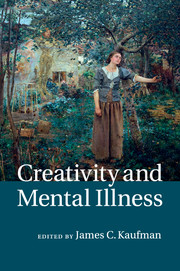Book contents
- Frontmatter
- Dedication
- Contents
- List of figures
- List of tables
- List of contributors
- Preface
- Acknowledgments
- Part I Creativity and mental illness: the state of the field
- Part II Cognitive and neuroscientific perspectives on creativity and mental illness
- Part III Creativity and the spectrum of mental illness
- Part IV Creativity and mental illness: possible commonalities
- Part V Creativity and mental health
- 15 Bringing the whole universe to order: creativity, healing, and posttraumatic growth1
- 16 Inspiration and the creative process1
- 17 King Solomon and psychoneuroimmunology: creativity and life coping
- Part VI Creativity and mental illness: what now?
- Index
- References
15 - Bringing the whole universe to order: creativity, healing, and posttraumatic growth1
from Part V - Creativity and mental health
Published online by Cambridge University Press: 05 August 2014
- Frontmatter
- Dedication
- Contents
- List of figures
- List of tables
- List of contributors
- Preface
- Acknowledgments
- Part I Creativity and mental illness: the state of the field
- Part II Cognitive and neuroscientific perspectives on creativity and mental illness
- Part III Creativity and the spectrum of mental illness
- Part IV Creativity and mental illness: possible commonalities
- Part V Creativity and mental health
- 15 Bringing the whole universe to order: creativity, healing, and posttraumatic growth1
- 16 Inspiration and the creative process1
- 17 King Solomon and psychoneuroimmunology: creativity and life coping
- Part VI Creativity and mental illness: what now?
- Index
- References
Summary
Past research and anecdotal accounts suggest that individuals pursuing creative work (especially in artistic fields) tend to report higher-than-average levels of challenging life circumstances, including experiencing adverse life events (Simonton, 1994) and psychological disorders (for reviews, see Jamison, 1993, Johnson et al., 2012; Kaufman, 2009; Ludwig, 1995). One explanation for these findings is the possibility, noted by researchers, creators, and laypeople alike, that creative work and activities confer benefits for the well-being of individuals who engage in them (Cropley, 1990, 1997; Winner, 1982). By engaging in creative work, individuals are given the opportunity to heal and grow from the challenges that have befallen them. Anecdotal accounts from eminent creative individuals suggest that engaging in creative activities – defined as activities that generate novel and useful ideas or products (Sternberg and Lubart, 1999) – appears to have therapeutic benefits. In her diary, the writer Virginia Woolf commented:
Odd how the creative power at once brings the whole universe to order. I can see the day whole, proportioned – even after a long flutter of the brain such as I’ve had this morning[;] it must be a physical, moral, mental necessity, like setting the engine off.
(Woolf, 1934/2003, p. 213)Woolf, known to suffer from bipolar disorder (Caramagno, 1992), expressed her belief that writing was essential to her well-being. Other eminent artists echoed a similar feeling with regards to either physical or psychological health. For example, the painter Paul Klee, who suffered from a severe autoimmune disorder, explained during the last stages of his disease: “I create – in order not to cry” (Sandblom, 1997, p. 187). The novelist and screenwriter Graham Greene, who also suffered from bipolar disorder, called writing “a form of therapy” (p. 37), and the confessional poet Anne Sexton, having composed verse based on the advice of her therapist, famously wrote that “poetry led me by the hand out of madness” (Jamison, 1993, p. 122). Finally, the French writer Antonin Artaud, who suffered from clinical depression, chronic pain, and addiction to opiates throughout his life (Rowlands, 2004), commented that “No one has ever written, painted, sculpted, modeled, built, or invented except literally to get out of hell” (Jamison, 1993, p. 121).
- Type
- Chapter
- Information
- Creativity and Mental Illness , pp. 321 - 342Publisher: Cambridge University PressPrint publication year: 2014
References
- 9
- Cited by



